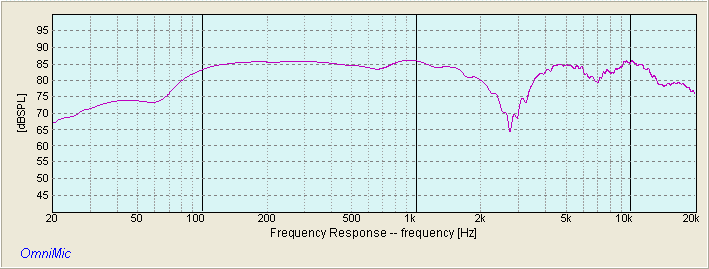|
Hummingbird It was one year ago that I tested the Dayton DSA135-8 with the Dynavox TD2801XL in an active system. The result was encouraging. Now, with some time available, I decided to work on the passive crossover. I shall start with the Dayton DSA135-8. While this 5″ aluminum cone midwoofer has certain attributes, it has one annoying weakness. And that is the frequency response.
Fig 1 is the RAW response of the DSA135-8. I honestly expected the response to be flatter than this. From my measurements, it dips -5dB after 2kHz. This limits the highest crossover frequency to 2.5kHz. Anything higher than that and I’ll run into trouble.
The Blue plot in Fig 2 is the DSA135-8 with a 12dB/oct Low Pass filter at a corner frequency of 2.5kHz. With this filter, the 8kHz peak from the cone breakup is -22dB below the fundamental. No additional network is needed to tame the peak as I doubt it will interfere with the sound.
Fig 3 shows the response of the DSA135-8 and the TD2801XL with their respective Low and High Pass filters. Crossover frequency is at 2.5kHz at 12dB/oct.
The Black plot in fig 4 is the summed response of the two drivers. No cancellations are observed on either side of the crossover frequency, indicating proper summing.
For a clearer picture, I removed the individual responses of the two drivers, leaving the frequency response of the Hummingbird. There’s a -5dB dip at 7kHz~8kHz but it’s nothing to worry about.
To check on the crossover, I rewired the TD2801XL tweeter in reversed phase. It resulted in a nice, symmetric notch at about 2.7kHz. The tweeter and the midwoofer are not time aligned but they are close. All it takes is to relief the DSA135-8 forward slightly and their acoustic centers will align.
Fig 7 is the waterfall plot of the Hummingbird. The artifact at 8kHz is from the peak of the DSA135-8 midwoofer. Even though it’s buried at -22dB by the crossover, the effect is still recorded. However, it will not interfere with the sound because it’s already down -30dB at 1 msec.
The Toneburst Energy Storage plot of the Hummingbird (Fig 8) shows minimal ringing. There are some excess energy at around 2kHz and 8kHz. Again, these are no cause for concern because they are all gone by 4 cycles.
The Spectrogram in Fig 9 shows the effect of the ringing at 2kHz. The Green patch at 4 msec is the ringing represented in the time domain.
The Hummingbird Distortion plot (Fig 10) shows no anomalies. Generally, the 2nd (Red) and 3rd (Violet) harmonics are about -55dB below the fundamental. There is a slight rise in the 3rd harmonic at 1.5kHz but it will not harm the sound.
The Hummingbird will not stress power amplifiers. The lowest impedance is 6Ω at 7kHz (Fig 11). In the lower midrange, it’s almost 7Ω at 250Hz. Electrical phase doesn’t deviate much from 200Hz~20kHz. The saddle to the left is the bass reflex box tuning. It shows the Hummingbird enclosure is tuned to exactly at 60Hz. Hummingbird Sound QualityI have only good things to say about the Hummingbird. First off, she displays an excellent midrange. The vocal clarity and instruments separation is outstanding. There’s no shrillness in female voices. Sibilance is well controlled. Stop This World (Diana Krall) is a joy to listen to. The sibilance in the recording doesn’t screech at you. Male vocals are free of nasalness. In Doolin-Dalton (Eagles), Don Henley doesn’t sound like he’s singing with a stuffy nose. More than that, there’s no honking caused by the baffle step, unlike in the Dayton PA200. As for the Hummingbird drivers, the treble is a bit of a surprise. I didn’t expect a $35 Dynavox TD2801XL tweeter to sound so refined. Though it doesn’t measure quite as well as some other tweeters, it sounds as good or even surpasses tweeters in the same price range. I did not detect any harshness or grittiness. And this is without a conjugate network to level the resonant frequency peak. A feature worth mentioning is the Hummingbird’s dynamics. Bass is tight and responsive, not limp and flabby like in so many budget drivers. In fact, the DSA135-8 dynamics remind me of one of the other Dayton drivers I own, the RS180s. Both exert wonderful control over the cone. The Dayton Designer Series is not marketing hype. They are actually superior to their cheaper models. Everything considered, the Hummingbird is impressive. It is only 7 liters but sounds bigger than the size would suggest. In a blind test, I wouldn’t believe that the music is coming from a 5″ midwoofer. Small. Sounds big. Vocals are clear as can be. Treble doesn’t make your ears bleed. Uncomplicated (read that as cheap) crossover. The Hummingbird is one of the designs I’m very proud of. You won’t be disappointed. Extending the Bass
|

August 4, 2019Projects
 Fig 1 – DSA135-8 RAW response. Ported Box = 7 liters. Baffle Width = 8-1/8″
Fig 1 – DSA135-8 RAW response. Ported Box = 7 liters. Baffle Width = 8-1/8″ Fig 2 – Black plot = RAW. Blue plot = 2.5kHz (12dB/oct)
Fig 2 – Black plot = RAW. Blue plot = 2.5kHz (12dB/oct) Fig 3 – Blue plot = DSA135. Red plot = TD2801XL
Fig 3 – Blue plot = DSA135. Red plot = TD2801XL Fig 4 – Black plot = Summed Response
Fig 4 – Black plot = Summed Response Fig 5 – Hummingbird Frequency Response
Fig 5 – Hummingbird Frequency Response Fig 6 – Null Response with TD2801XL wired in Reversed Phase
Fig 6 – Null Response with TD2801XL wired in Reversed Phase Fig 7 – Hummingbird Waterfall
Fig 7 – Hummingbird Waterfall Fig 8 – Hummingbird Toneburst Energy Storage
Fig 8 – Hummingbird Toneburst Energy Storage Fig 9 – Hummingbird Spectrogram
Fig 9 – Hummingbird Spectrogram
 Fig 11 – Hummingbird Impedance
Fig 11 – Hummingbird Impedance